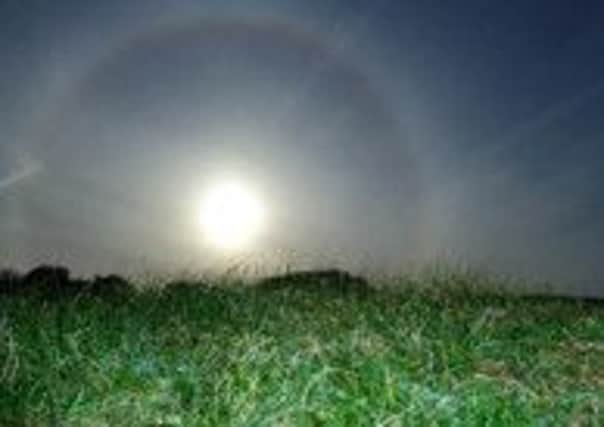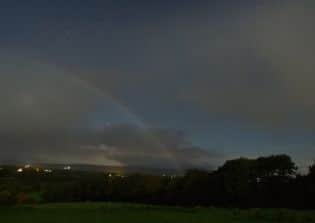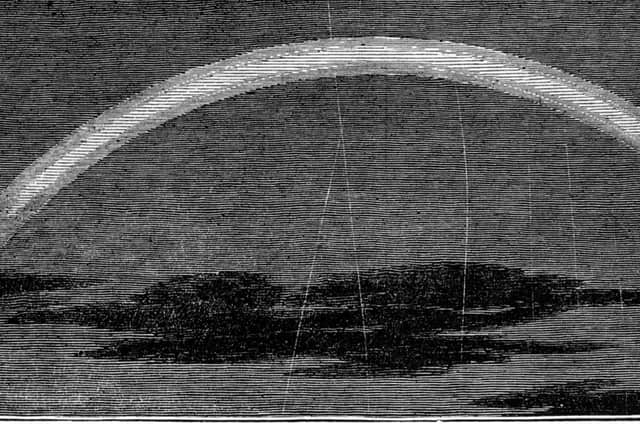Mansfield and Ashfield’s fascination with the sky


Sometimes known as moonbows, lunar rainbows are one of the rarest spectacles. They form in the same way as day-time rainbows, when sunlight passes through water particles in the atmosphere. This splits the light into its component colours to form the rainbow spectrum.
The difference is that lunar rainbows are formed through the refraction of moonlight - sunlight that is reflected off the moon’s surface. This means they often appear fainter than solar rainbows and whiter in colour.
Advertisement
Hide AdAdvertisement
Hide AdThey only occur when rare astrological and weather conditions allow.


Moonbows can only form two days either side of a bright full moon which must be no more than 42 degrees from the horizon. Moisture particles also have to be in the atmosphere.
John Wilson, a local weather expert, said: “I suspect the lack of modern sightings is due to light pollution, bright street lighting would make them invisible when they occur.”
Nonetheless hundreds have been seen in the past.
One of the first was in Glapwell in 1710. It had come to the attention of the Royal Society, a fellowship of eminent scientists who met in London to discuss the latest scientific theories and interesting natural phenomena.


Advertisement
Hide AdAdvertisement
Hide AdThe society recorded: “A gentleman of great veracity and ingenuity was in Derbyshire on Christmas day. He was at Glapwell Hall and walking towards Patterton-Green at about 8pm when he observed the luminous arch.”
Another occurred on 17th July 1802 in Mansfield Woodhouse. A correspondent to the Gentleman’s Magazine reported that a lunar rainbow was seen for about 10 minutes in the evening.
The lunar observatory in Beeston observed another when a “beautiful and perfect lunar rainbow” was seen on September 23 1856. It was: “Colourless, brilliant but flickering, there was a faint secondary arch.”
Night-time rainbows are not the only spectacle - others include lunar and solar halos which appear as circles of light around the moon and sun.
Advertisement
Hide AdAdvertisement
Hide AdMr Wilson said: “They are found when there is a layer of very high cloud which consists of tiny ice crystals. The ice crystals refract the light, like a glass prism, and produce the halo effect.”
One was reported in the Nottinghamshire Guardian on 30th January 1890, which said: “A correspondent informs us that last evening at 6.30 a curious double rainbow was observed. It consisted of a halo centric to the moon.”
Other phenomena include mock moons and suns. Also known as sun or moon dogs they form because ice crystals in cirrus clouds refract to show lights on either or both sides of the sun or moon.
One instance was on Sunday 12th June 1870 when a mock moon was observed at Ollerton at 9.45pm. It was to the left of the moon and “of a dull red colour”.
Advertisement
Hide AdAdvertisement
Hide AdThe Nottinghamshire Guardian said: “It denoted great changes in the weather they are seldom seen in this country though common in northern climes. Formerly the superstitious regarded such displays as portents.”
The day time variety was seen on 3rd November 1855. Mr E.L. Lowe, from the observatory in Beeston, reported a mock sun, saying: “An inverted arc of a circle of 22.5 degree Radius became visible. It disappeared on a number of occasions and became visible again. This transformed into the common halo which had a mock sun on its northern side.”
James Ince, Chairman of the Bassetlaw Astronomical Society, said: “Such phenomena can still be seen given the right conditions. Moon and sun dogs occur regularly in the springtime and often after storms.”
Mock suns, like solar halos, are however harder to spot because the glare of the sun tends to obscure them and extreme caution should be used when looking at the sun. No-one should look directly at the sun especially with a telescope or binoculars at any time of the year.
Advertisement
Hide AdAdvertisement
Hide AdOctober 1859 was an extraordinary month for optical phenomena. Mr Lowe reported: “The prevalence of solar and lunar halos and mock suns of late is worthy of notice.”
Lunar halos appeared on the 3rd, 4th, 9th, 10th, 11th, 12th and 13th of October. The solar variety appeared on the 10th, 11th, 12th and 13th. Often they were reported several times each day.
He also reported four mock suns on the 5th October, two on 11th October and seven on 12th October.
On 13th October 1859, at 3am, Lowe also reported an appearance of the aurora borealis. Known more widely as the northern lights they appeared during a severe frost.
Advertisement
Hide AdAdvertisement
Hide AdNormally seen in countries such as Norway they are the lights in the sky caused when electrically charged particles in collide with atoms at high altitude.
There were many other reports. As early as 1794 Hayman Rooke, an antiquarian who kept a meteorological register of the weather at Mansfield Woodhouse, reported the aurora as a “white steady light” near Mansfield on 21st October.
Anyone who is interested in learning more about the night sky in Nottinghamshire can visit the Sherwood observatory hold open days throughout the year. Visit http://www.solarius.net/ for more information